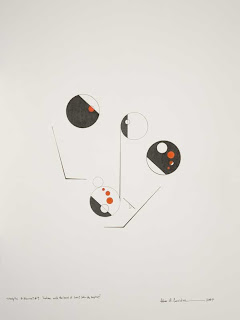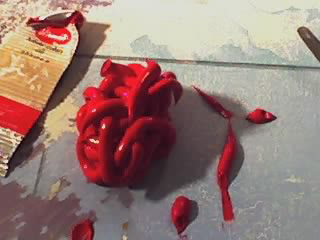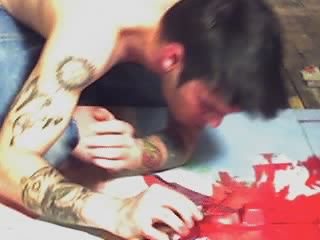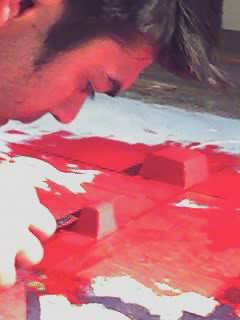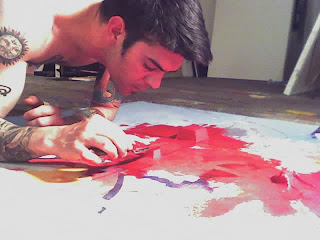2.3.1 On the choice of surface for the application of oil paint.
Let's keep this simple, and talk briefly on the types of surfaces that I have painted on. An oil painter typically choses canvas or panel to work on. Most see only these two commonly used surfaces as options, and tend to disregard other useful surfaces. Realistically, if you can imagine a surface, it can be painted on with oil paints with the proper preparations.
Like any tool, the choices of surfaces to paint on, are a preference for the artist to make per concept. That choice of surface should simply be one of personal preference, but a decision based on the intended concept of the oil painting. Different ideas demand different surfaces, and some concepts require a rough canvas, where others will ask for the smooth surface of a panel. Personal preference is everything. All artists will work with what they identify with, that results in style, as style and singular visions should be avoided. Making a decision on what type of surface to use is personal and conceptual. There are an infinite number of choices to paint on, and again the artist will know what surface is best for a work of art. Compositional oil painting, or communicative oil painting that opens a dialogue with an intended audience, demands that the artist use only the materials that are conceptually important to achieve the end result of the artist’s concept and intended form of communication.
Both canvas and panel have limits and strengths. The canvas, if stretched properly, is as firm of a surface as a panel, and although canvas has a slight give to it as the brush eases against its surface, it is taunt enough to easily control. This give should be barely noticeable, and it aids the painter’s ability with brush control. Canvas has a bounce to it, and if properly stretched, should sound as a tight drum when tapped on. I prefer the smooth texture of extra-fine linen. Linen is stronger and more resilient than canvas. Linen lasts longer and takes repairs better than canvas. Linen is by far the best fabric surface to oil paint on far as I am concerned, as my experiences with painting on linen has always been favorable. Within fabrics there are many selections of the type of weave, from smooth to rough, along with the weight, heavy to light. The weave of a canvas will determine how your oil paint lays on the surface.
A wood surface is the premium choice of panel for the oil painter. It is absorbent and strong, with a little flex, which leads to the permanence of the work. A wood panel is solid, which protects the longevity of the painting; and depending on the type of wood used, the grain shows little of itself through the oils over time. If prepared properly, the wood grain will never show itself in the face of the painting.
Oil paints can be painted on metal surfaces like copper, steel, iron, bronze, and aluminum. Oil paints on metals dry slower than on other more absorbent surfaces, and if the metal surface is not prepared properly, the oil paint will crack and possibly (probably) flake off as the oils cure. Very few oil paintings done on metal surfaces have not blistered or pealed or flaked off through time. The oil medium has also been known to simply leak out the front of the painting with nothing to absorb into. It is best to use enamel paints on metal. I still feel that there is no real way to know how long oil paint will last on metal surfaces. In regards to painting on aluminum, I warn the oil painter to simply avoid it. Oil paint has been proven to not adhere to aluminum unless the surface is first treated by anodizing. Aluminum must be treated with a heavy coat of aluminum oxide, it is permanent and absorbent enough for oils to stay in place as they cure. Without treating the aluminum, the oil pigments will fall off once they are dry. I have used stainless steel once, and it is a better surface than aluminum to paint on, although it reacts much like aluminum, unless treated properly. I would just simply avoid oil painting on metal, unless your idea is based on the process, simply because oil painting on metal is a pain in the ass. If you are going to use oil paints on any metal surface, I suggest deeply scratching the surface with a corse sandpaper and sharp tool. The scratches will give the paint something to cling to as it dries.
I worked on glass once, and it just sucked. A client commissioned me to paint a landscape on glass in oil paints, so I had to do it. Painting on glass is much like painting on metal. Its surface is slick and oils glide regardless of what type of preparation you work into the surface. Just avoid oil painting on glass...it is stupid, just stupid.
Preparing any surface to paint on varies with each type of material. Oil painting surfaces must be primed with something. Oil pigments use a vehicle to bind the pigments together and they normally contain linolenic acid which will destroy the fabric fibers over time. So primer truly is there to protect the life of an oil painting. There are two standards: 1) Gesso, and 2) rabbit skin glue. Rabbit Skin Glue was the preferred method for traditional oil painters during the renaissance. I used rabbit skin glue as a part of my training as an oil painter, but I truly prefer oil based gesso.
The way I have applied Gesso is simple and time consuming. Gesso is liquid plaster that comes in both an oil-based and acrylic water-based medium. Brush an even coat of Gesso to your chosen surface, allow it to thoroughly dry. With the finest grade sandpaper, sand down the gesso evenly, and then re-apply a second coat; again sanding the surface down evenly. Repeat this process as many times as needed to acquire a smooth, even, painting surface. A better method to apply Gesso to an unprimed surface is to lay your surface on its back. Mix an oil based gesso and wipe on a very thin coat with a rag, gently rubbing the gesso into the weave of the fabric. Allow your first coat to dry and repeat two more times. Preparing your painting surface with Gesso as a base primer to apply oil paints to, is necessary so that the oils have something other than the surface material to absorb into.
Preparing your canvas prior to stretching it is a fools errand. Unless the canvas comes pre-primed, priming it un-stretched ends in a disaster every time. The weave of your fabric will shrink unevenly and cause wavy movement in your canvas, and eventually if not immediately, will just crack and flake off after you stretch it.
Some artists have chosen not to prime their painting surface, applying oil paints directly to the material. Francis Bacon painted on the backs of pre-primed canvas, where the first intended mark was permanent and virtually unchangeable. This is fine, but eventually the oils will destroy the fabric.
I like to use pre-stretched Belgium antwerp linen, portrait grade triple-primed, with oil-based Gesso. Pre-stretched linen is expensive, but to properly stretch and prime a linen surface is very time consuming. Time is money and I would rather pay for the consistent surface most art stores offer. I have stretched my own canvas many times, and although the process is necessary in the training of an artist, it teaches the artist what to look for in a pre stretched canvas. It is rewarding in the training and knowledge, but its very time consuming.
When it comes down to it, simply paint on anything you want...









